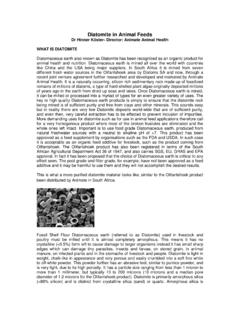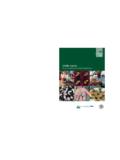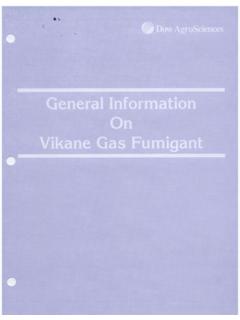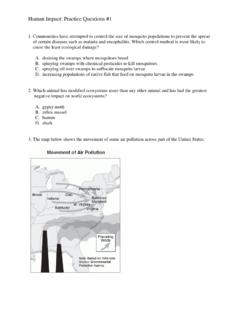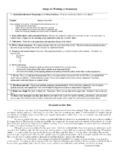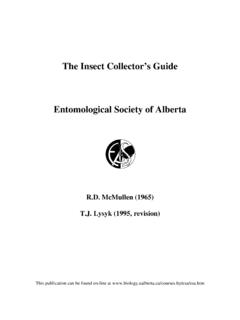Transcription of Environmental Monitoring Outline Methods to Determine …
1 1 Environmental Monitoring Methods to Determine the Effectiveness of Sterilization and Sanitation Procedures inan Animal FacilityJulius E. Thigpen, PhDQAL, CMB, NIEHSMay 18, 2012 Presentation Outline Background: Why do EM Sanitation? feed & Bedding: Autoclave or Irradiate Methods to assess sterilization procedures Water: RO/DI , Tap or Hyper chlorinated Methods to assess water quality Methods to assess Sanitation Procedures: Swab rinse method, TPC s, RODACs, ATP? Rooms, cubicles, floors Supplies cages, water bottles, sipper tubes Cage/rack washers, etc. How to Determine Pass Fail, Cut off Values Advantages & Disadvantages of RODACs vs ATP Based Systems Pest Control Methods ConclusionsSOURCES OF MICROBIAL CONTAMINATIONAirFeedAnimalCaretakersBedd ingOther AnimalsInsect PestsWaterEquipment and AccessoriesThigpen, et al ILAR, 2004; 45 Environmental Monitoring RATIONALE1. Recommended AAALAC Accreditation Guide for the Care and Use of Laboratory Animals2.
2 Provides Data to Support Quality of Research detects/prevents potential disease outbreaks prevents transmission/spread of disease agents reduces number of animals used4. Establishes Manageable Limits or Acceptable Levels5. Detects Malfunctioning Equipment6. Evaluates Effectiveness of Sterilizing and Sanitizing Procedures7. Improves Sanitary ConditionsENVIRONMENTAL Monitoring QUESTIONS1. Responsible Person(s)2. What to Monitor?3. When to Monitor?4. How Often (Frequency)?5. Which Procedures to Use? Routine procedures Emergency procedures6. Can You Use or Justify Results? Environmental Monitoring RESULTSARE THE RESULTS? :1. Accurate? Confirmed?2. "Within" Acceptable Limits?3. "Outside" Acceptable Limits?If "yes", activate corrective action plan(s).4. Reports To: Attending veterinarian Facility Manager/Supervisors Investigators File2 Rodent FeedBulk Shipments of Rodent DietsFeed GrinderQUALITY ASSURANCE OF feed (#1)Each Shipment Assayed ForAcceptable Concentration(TPC/g)1.
3 Microbial Quality:Non autoclaved FeedSalmonella <50,000 Coliforms < 5,000 Fungi/Yeasts <10,000 Autoclaved feed TPC0 Coliforms0 Autoclaved feed Salmonella sp. 0 (Dispenser Bins)TPC <200 Coliforms < 30 Fungi/Yeasts <2002. Nutritional QualityProtein, Fat, Vitamins, etc. *Moisture Physical PropertiesPellet Hardness< * = Contract SpecificationsQUALITY ASSURANCE OF ANIMAL feed (#2)Each Shipment Monitored ForI. Chemical Contaminants:PermissibleLevels A. Pesticide Screens I, II, & III1. PCB s Total Aroclors< ppm2. Organo phosphates Diazinon, Malation,< Chlorinated hydrocarbons Aldin, Dieldrin< ppmEndrin, BHC's, Lindane, Chlordane, Nitrosamines NDMA, NDEA, NDPA, etc.< ppbC. Mycotoxins Aflatoxins< ppb Fumonisins< ppmD. Heavy Metals Arsenic< ppm Mercury< ppm Lead< ppm Cadmium< ppmNOTE: Results Must Be Completed Before USEQUALITY ASSURANCE OF ANIMAL feed (#3)MaximumEstrogenic AssaysConcentrations1.
4 Total Estrogenic activity Mouse uterotrophic bioassay Mouse vaginal opening bioassay2. Phytoestrogen chemical assays 1 Daidzein & Genistein (NIH 31 diet)<100 g/g diet Soy alfalfa free diets< 10 g/g diet AIN 76A purified (casein diet)< 5 g/g diet3. Estrogenic mycotoxins chemical assays<100ppb Zearalenone3 Phytoestrogens in my lab animal diet?Copyright 2008. Research Diets, Inc. All rights OpeningClosedOpenThigpen et al, Why is the VO Endpoint Important?1. The vaginal canal is not open prior to the onset of The bioassay is conducted in pre-pubertal female mice/rats. VO endpoint is an estrogen-sensitive biomarker of sexual maturation in time of VO can be significantly accelerated by: Endogenous estrogens Normal growth High total metabolizable energy (ME) Exogenous estrogens Dietary estrogens/phytoestrogens Zearalenone Corn-cob bedding Bisphenol A Caging and water bottles?
5 ?5. VO determination does not require that animals be FUNCTIONI tems MonitoredAssayed ForFrequencyChartsTemperatureEach LoadTapesColor ChangeEach LoadBiological IndicatorsSterilityWeekly Chemspor* Kilits VerifyFeedSterilityWeeklyBeddingSterilit yWeeklyDART**Color ChangeAs Needed (problems)*Lowest Shelf on Rack, Middle of Bag, Above Drain **Direct Air Removal TestDumping Rodent Diets in Automatic feed Dispensing System4 feed Pellet Hardness TesterThigpen et al, Rodent BeddingVariables Affecting Endotoxin Content in Rodent Bedding Type of bedding Bedding source Seasonal variability Storage conditions (outdoor and indoor) Bacterial and fungal loads Processing procedures Batch to batch variability Dust content Shipping conditionsPile of Corn CobsTruck load of Corn CobsBulk Shipment of Hardwood BeddingQUALITY ASSURANCE OF ANIMAL BEDDING (#1)Microbial QualityAssayed ForAcceptable(TPC/g)I.
6 Non AutoclavedSalmonella ,000 Coliforms200 Fungi/Yeasts200II. AutoclavedSterility0 III. Autoclaved(Dispensers)Salmonella <100 Coliforms0 Fungi/Yeasts<1005 QUALITY ASSURANCE OF ANIMAL Bedding (#2)Each Shipment Monitored ForPermissible Levels1. Pesticide Screens I, II, and IIII PCB's Aroclors< ppmII Organo phosphates Diazinon, < ppm MalathionIII Chlorinated Pesticides Aldin, < ppm BHC's, Endrin, Lindane, Pentachlorophenol (PCP)< ppm3. Physical Characteristics; Dust < Particle Size, Etc.*4. Microbial Sterility**See other Tapping Sieve Shaker for Measuring Dust Content and Particle SizeAUTOCLAVE FUNCTIONI tems MonitoredAssayed ForFrequencyChartsTemperatureEach LoadTapesColor ChangeEach LoadBiological IndicatorsSterilityWeekly Chemspor* Kilits VerifyFeedSterilityWeeklyBeddingSterilit yWeeklyDART**Color ChangeAs Needed (problems)*Lowest Shelf on Rack, Middle of Bag, Above Drain **Direct Air Removal TestAutomated Bedding Dispensing SystemWear Appropriate PPE Face masks Hair bonnets Coveralls Respirators Gloves RO/DI Water System6 QUALITY ASSURANCE OF ANIMAL SUPPLIESWATER MONITORED FOR /FREQUENCY1.
7 Microbial Quality Coliforms / weekly TPC / weekly P. aeruginosa / weekly Endotoxins / weekly2. Chemical Quality Conductivity / weekly Total Trihalomethanes / 6 months Total Carbon / 6 months Total Organic Halides / 6 months Heavy Metals*/ 6 months Individual Elements (40) / 6 months*Lead, Mercury, Arsenic, Barium,Cadmium, Silver, Selenium, and Cage/Rack Washer Sanitation Methods of Microbial Monitoring to Determine the Effectiveness of Room and Cage/Rack Washer Sanitation Procedures1. Replicate organism detection and counting (RODAC) or contact plates Direct agar impression technique developed by the US Public Health Service and recommended by American Public Health Association for surface sampling to Determine the effectivenessof cleaning procedures2. Swab Rinse Method (2 x4 area) for flat surfaces Rinse in liquid agar (56 C) Incubate 24 48 hrs, Determine TPC (<50 per swab)3.
8 Swabs BG broth durham tube: culture for coliforms; Water bottles/sipper tubes4. Adenosine Triphosphate (ATP) Bioluminescence Accupoint ATP Neogen, Inc NovaLUM ATP Charm Sciences, Inc System Sure Plus ATP HygienaAPHA Guidelines for Interpreting RODAC Plate CountsColonies per RODAC PlateCritical AreasGoodFairPoorFloors , , Isolation (terminal clean-up)Nursery Table TopsPatient rooms Floors Table TopsBathrooms FloorsSinks & Tubs Toilet seatAll other floors All other horizontal non-porous surfaces0-50-50-250-50-250-150-50-250-56 -156-1526-506-1526-5016-256-1526-506-151 6 and up16 and up51 and up16 and up51 and up26 and up16 and up51 and up16 and upAPHA, Plates7 Swab Rinse MethodEM SANITIZED ROOMS Swab Rinse Method To Assess Sanitizing ProceduresSamplingMicrobial TPCArea*No. Samples BeforeAfter**Work Station2___<50 Sink2___<50 Counter Top2___<50 Floor4___<50 Vent(s)2___<50 Balance2___<50*2" x 4" Area **>50 TPC = Room Must Be Re sanitizedDetection of ColiformsTemperature Tapes8 Different ATP Systems for Determining the Effectiveness of Sanitation Procedures1.
9 Accupoint ATP Neogen, Inc (distributed by Quip Laboratories)2. NovaLUM ATP Charm Sciences, Inc (distributed by Pharmacal Research)3. System Sure Plus ATP Hygiena(distributed by Sanitation Solutions)AccuPoint NovaLUM ATPC omparison of RODAC vs ATPG uidelines for Establishing Pass/Fail Cut Off ValuesItems MonitoredRODAC Readings(CFUs)ATP Readings(RLUs)Pass FailPass FailAnimal Rooms: Floor (Epoxy)WallsCounter TopsWork Station< 25 > < 25 > < 25 > < 25 >Must Establish Own ValuesWaterWater BottlesSipper TubesN/A N/A N/AMust Establish Own Values*Mouse CagesFloors:-Single Mopping-Double Mopping< 10 > < 200 > < 10 > < x 104> < 120 x 104> < 40 x 104>*Ednie et al.
10 1998 vol 37(6): 71 74 Contemporary Topics Readings=quite variable9 RODAC PlatesAdvantagesDisadvantages Detects live bacteria, fungi and yeasts TPC & identification Detects beta hemolysis-Staph aureus Established guidelines for interpretation of RODAC plate counts Results in 24-48 hours Corrective action taken after 24-48 hoursATP Bioluminescence AssaysAdvantagesDisadvantages Computerized results within minutes Allows for immediate action Detects organic matter, food residue, biofilm, microbial agents Measure of the actual cleanliness Initial cost may be expensive Does not identify pathogenic bacteria Must establish RLU values for each area or equipment monitoredNIEHS Wild LifeNIEHS Wild Life Helicobacter ProfileAnimal Species# Samples/ # PositiveHelicobacter speciationWild Mice38/51 (75%)Helicobacter rodentium, *hepaticus, *typhlonius, *anmani, apodemusand speciesFlying Squirrel4/4 (100%)Helicobacter bilisand speciesMole2/2 (100%)Helicobacter species and Helicobacter sp.

